
|
Sale 80
June Pre Long Beach Sale
| Lot |
Photo |
Description |
Realized |
Lot 314 |
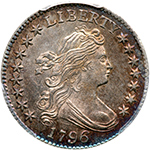 |
1796 JR-4, R-4. PCGS graded MS-63. Lovely blue and golden obverse toning. Frosty white on the reverse. Only 22,135 minted. A scarcer die pairing from this highly collectible premier issue, estimated to be about 10 percent of the present number of 1796 Dimes. It is one of the best struck die marriages for the year and can be identified by the tips of leaves being aligned with the edges of the A in STATES and the F in OF. Additionally, the TY in LIBERTY is joined at the top of the letters.
An especially colorful lustrous Mint State 63, we might almost say that it is a benchmark for other examples that share this choice grade. While the strike is bold and crisp, it is not quite full, but only on the eagle�s chest feathers, elsewhere the design features are exceedingly sharp. None of the head or drapery details are left to the viewer's imagination, for instance. A word of caution here: hesitant bidders will promptly be left out in the cold when this attractive Draped Bust, Small Eagle classic hits the auction block.
The dime has long been an indispensable part of the United States decimal monetary system, although it was one of the last coins issued by the Mint when operations first began in 1793. By the time it arrived in 1796, as the Draped Bust/Small Eagle type, the Mint had already been striking copper cents and half cents for three years; silver dollars, half dollars and half dimes for two years; and two gold coins -- the eagle and half eagle -- for a year. The only other coins delayed, like the dime, until 1796, were the quarter dollar and quarter eagle.
The Draped Bust/Small Eagle design by Mint Chief Engraver Robert Scot features a rather fully formed portrait of Liberty, her fluid hair tamed somewhat by a ribbon and her bust covered with drapery, encircled by stars at the sides. The inscription LIBERTY appears above and the date below. The reverse depicts a small, spread-winged eagle perched upon clouds and surrounded by palm and olive branches. Encircling this is the motto UNITED STATES OF AMERICA.
Pieces dated 1796 have fifteen stars-one for each state in the Union then. In 1797 some dimes were struck with sixteen stars (reflecting Tennessee's admission as the 16th state) and some with thirteen, symbolizing the thirteen original states. Such dies were prepared after the Mint abandoned the idea of adding an extra star for each new state. Pop 13; 24 finer, 8 in 64, 6 in 65, 9 in 66, 1 in 68 (PCGS # 4461) .
Estimated Value $30,000-UP.
View details and enlarged photos
Check results on similar lots
| Realized
$45,825 |
Lot 315 |
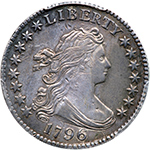 |
1796 JR-5, R-5. PCGS graded Genuine AU Details. Repaired. Nice even grey toning. Rarity-5. Two berries under upright of the E in UNITED, first star touches a curl. According to the standard Early United States Dimes reference, JR-5 is the "rarest 1796 variety."
Thomas Jefferson had called for a one-tenth dollar coin as far back as 1783, as part of a proposed decimal system. He was joined in his advocacy by Benjamin Franklin, Alexander Hamilton and the man who would become the first mint director, eminent scientist David Rittenhouse. The decimal system was gradually gaining acceptance for use with calculations, but it had not yet been used for any nation's monetary structure. The founding fathers believed that not only was decimal coinage an efficient, workable method for commerce, but it also symbolized a break from the Old World.
Hamilton, the nation's first treasury secretary, bolstered this view in 1791 in his formal report to Congress, outlining a plan for a national mint and coinage. He recommended the issuance of coins in six denominations-including a silver piece "which shall be, in weight and value, one tenth part of a silver unit or dollar." He suggested that the dollar be called the "unit," with its tenth part being known as simply a "tenth."
1796 is the first year of issue. Six die marriages are reported (PCGS # 4461) .
Estimated Value $4,000 - 4,500.
View details and enlarged photos
Check results on similar lots
| Unsold |
Lot 316 |
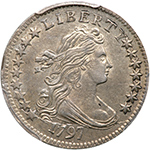 |
1797 JR-1 Rarity 4. PCGS graded MS-61. 16 Stars. Frosty and mostly untoned on both sides. The 1797 Dimes comprise two main varieties, with 16 Stars and 13 Stars obverses, the latter issued after Mint personnel became aware of the fact that to continue adding stars as new states joined the Union would prove futile. Only a single reverse die was used with both obverses, producing the two varieties known for this date. The present MS61 coin has 16 Stars and is listed as JR-1; it is better struck than usually seen, showing excellent motifs with only negligible softness in the centers. Marks are present only in a small number of areas; the only contact of note is a short planchet depression at the top of Liberty's breast. The satiny surfaces display a mere veil of golden-gray patina on either side, producing an attractive Mint State example of this very scarce early dime die combination. Sure to endear itself Early Dime specialist. Pop 2; 7 finer, 3 in 62, 1 in 64, 1 in 65, 2 in 66 (PCGS # 38748) .
Estimated Value $28,000 - 30,000.
View details and enlarged photos
Check results on similar lots
| Realized
$31,725 |
Lot 317 |
 |
1802. PCGS graded AU-53. Traces of golden mint luster are quite evident, mixed with natural antique tones. Only 10,975 struck. Pop 2; 11 finer at PCGS. (PCGS # 4472) .
Estimated Value $12,000 - 13,000.
View details and enlarged photos
Check results on similar lots
| Unsold |
Lot 318 |
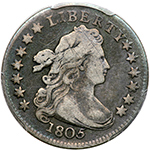 |
1805. 4 berries. JR-2. PCGS graded VF-20. Lovely light blue toning. Attractive surfaces and appearance (PCGS # 4477) .
Estimated Value $1,300 - 1,400.
View details and enlarged photos
Check results on similar lots
| Realized
$1,410 |
Lot 319 |
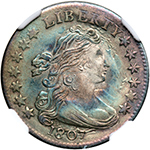 |
1807 JR-1. NGC graded MS-64. Lovely blue and gold toning. Tiny marks in the reverse clouds. Struck from clashed dies. The reverse die for the 1807 dime had previously been used to strike four quarter eagle issues: the 1805, 1806/4, 1806/5, and 1807. Once it was converted to use for dimes dated 1807, well over 100,000 pieces were produced! As a result, most of the examples known today display multiple die problems, including weakness on the left side of the obverse, die clashing in the right obverse field, repolishing, and missing peripheral detail on late strikes.
A nice representative example of the 1807 Dime, the present piece is in MS64 grade. Both obverse and reverse are deeply and richly lustrous, overlaid with light lilac and blue toning that includes splashes of gold, with the main instance of blue iridescence concentrated in the centers. In all areas the striking details are uneven, and typical, indeed the 1807 date makes a good numismatic study year for die progression and relapping of clashed dies. All told it is a illustrative example of the date and type. Pop 21; 17 finer, 14 in 65, 2 in 66, 1 in 67.
Estimated Value $14,000 - 15,000.
View details and enlarged photos
| Realized
$16,450 |
|
|